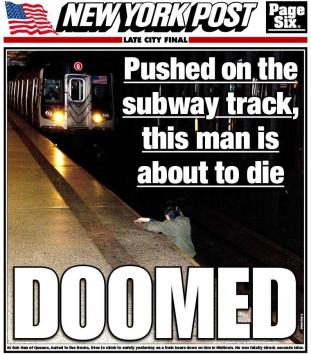
New York Post cover, subway death, 12-4-12. Photograph by R. Umar Abbasi.
On December 3, 2012 Naeem Davis, a 30-year-old mentally disturbed homeless immigrant from Sierra Leone, allegedly pushed to the subway tracks at the 49th St. station of the Q train in Manhattan a drunken 58-year-old Korean immigrant, Ki-Suck Han, who died seconds thereafter, crushed by an incoming train.
Han’s gruesome death kicked off a furious debate over the ethics of photographing crises, large and small, in which lives are immediately at stake, and the appropriateness of publishing the resulting images.
This issue arose because R. Umar Abbasi, a freelance photojournalist coincidentally present at the scene, made images of the tragedy as it unfolded, one of which shows the victim, his back to the camera, with the train bearing down on him. It ended up on the front page of the December 4 New York Post. This image and its genesis have evoked a barrage of commentary centered around two questions:
● Did Abbasi have a moral obligation to try to help Han to safety that trumped his making images of the man’s plight?
● Did the Post violate journalistic ethics by publishing the images, especially the one it used on its front cover?
This put the discussion in my bailiwick. So, in a short series of posts, I did my best to explicate some of the premises of press photography and photojournalism specifically and professional witnessing more generally. The links below will take you to my responses, the most recent first. I suggest starting with the earliest post and working your way forward from there.
- The Photographer as Citizen 4 (December 12, 2014): In which I return to this now-forgotten incident for reconsideration. With the dust long since settled, and the bloviators distracted by their latest enthusiasms, I address at length the nonsensical analogizing of Abbasi with Kevin Carter, including a brief review of Alfredo Jaar’s mawkish Carter-inspired installation, “The Sound of Silence.”
- The Photographer as Citizen 3 (December 28, 2012): In which I empathize with Abbasi’s dilemma, based on my own lifetime of experience with the NYC subway system, and examine the ethical implications of the testimony by John Long of the National Press Photographers Association that the majority of that organization’s members don’t abide by the NPPA’s published Code of Ethics.
- The Photographer as Citizen 2 (December 25, 2012): In which I refute assorted crazy talk and stupid talk evoked by this event, including questionable assertions by Kenneth Irby of The Poynter Institute for Media Studies and John Long, Ethics Committee Chair of the Chair of the National Press Photographers Association. Plus further thoughts on simplistic readings of Kevin Carter’s decision.
- The Photographer as Citizen 1 (December 16, 2012): In which I lay out the facts as reported up to that point, consider an investigation that suggests discrepancies in Abbasi’s account of his role in the event, and reject comparison of his image with Kevin Carter‘s stark 1993 image of a starving Sudanese child crawling toward a rescue station, and comparison of his inaction in the situation to Carter’s.





